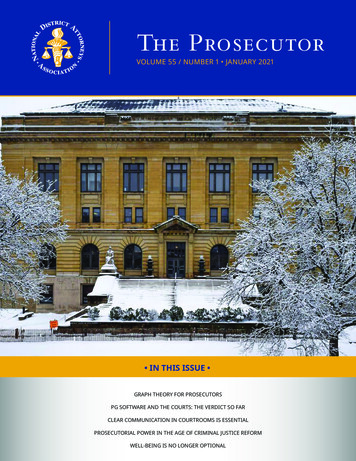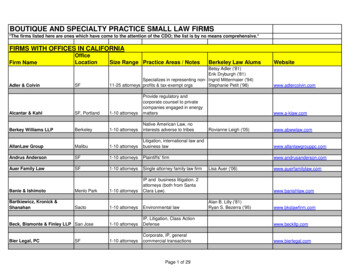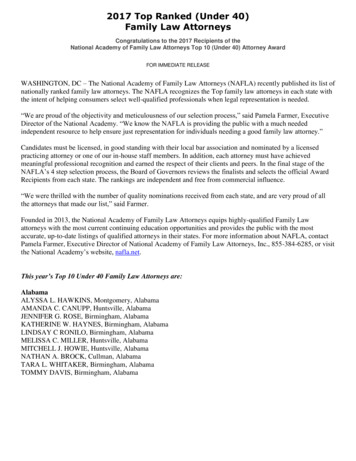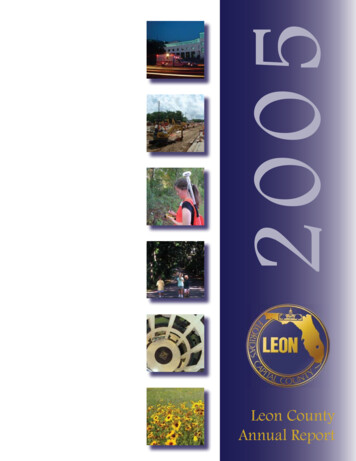
Transcription
The ProsecutorVOLUME 55 / NUMBER 1 JANUARY 2021 IN THIS ISSUE GRAPH THEORY FOR PROSECUTORSPG SOFTWARE AND THE COURTS: THE VERDICT SO FARCLEAR COMMUNICATION IN COURTROOMS IS ESSENTIALPROSECUTORIAL POWER IN THE AGE OF CRIMINAL JUSTICE REFORMWELL-BEING IS NO LONGER OPTIONAL
JOIN US!2021 VIRTUAL NDAA CAPITAL CONFERENCEFebruary 2–3, 2021Coinciding with the start of the 117th Congress and new incoming Presidential Administration, NDAA’s Capital Conference gives you theopportunity to hear directly from Administration, agency and Capitol Hill speakers. Join us for the first ever Virtual Capital Conferencefor an online educational and networking event that lets you connect directly with policy makers in this unique advocacy environment.SPEAKERS INCLUDE: Key Members of the House & Senate Judiciary Committee Advocates who have adapted to the online policy environment U.S. Department of Justice representatives from the new Presidential AdministrationThis year’s conference will also include a virtual session on our 2021 legislative priorities and how you can help advocate directly withyour legislators. Learn more and register here: rtual CLE Learning Sessions (Webinars)NDAA is making our National Courses available to you virtually!Our courses cover a wide range of issues, from human trafficking and domestic violence, to lessons on leadership and prosecutorwellness. We have variety of topics to meet all your CLE needs! New course offerings will be published on regular basis. Check out a fulllist of our virtual learning sessions at https://ndaa.org/training-courses/Special Note: Select courses have been approved for CLE credit by the Virginia State Bar and may provide ethics credit.Join us for our upcoming virtual sessions! Modern Ethics for Prosecutors: Handling Cases in a Court of Law, and the Court of Public Opinion — January 13, 2021, 1:00 pm–2:00 pm EDT Prosecutor-led Diversion: Best Practices for People with Substance Use Disorder — January 22, 2021, 2:00 pm–3:30 pm EDT Galvanizing Gatekeepers: The Prosecution’s Role in the Current Immigration Landscape — January 26, 2021, 1:00 pm–2:15 pm EDT Successful Strategies for the Newly Elected or Appointed Chief Prosecutor — January 27-29, 2021, 11:30 am–5:00 pm EDT Threat Assessment for Prosecutors: Protecting the Community from Dangerous Defendants — February 8, 2021, 2:00 pm–3:00 pm EDT Ethical Issues in Charging Considerations — February 9, 2021, 1:00 pm–2:00 pm EDT Diversion: A Rehabilitative Approach to Reduce Gun Crime — March 2, 2021, 2:00 pm–3:00 pm EDT Discovery: Stay Out of Trouble — Knowing the Rules and Ethical Considerations — March 22, 2021, 1:00 pm–2:30 pm EDT Win Win Animal Abuse Prosecutions! — April 5, 2021, 1:00 pm–2:30 pm EDT May It Please the Court: Ethical and the Professional Responsibility Issues During Trial — April 30, 2021, 1:00 pm–2:30 pm EDTOn-Demand Offerings! Prosecuting DUI Cases Mastering Masking Digital Course Human Trafficking and the Impact on Commercial Driver’s LicensesNDAA Has Online Resources for Your CLE Needs!During the COVID-19 crisis, NDAA is here to provide our members and the broader legal community access to online trainings withCLE credit in order to help satisfy state bar requirements. Our goal is to ensure that lawyers throughout the country continue toreceive the vital training needed as our criminal justice system undergoes unprecedented changes.If you have questions or require more information, please send an email to training@ndaajustice.org.Register for any of these webinars at https://ndaa.org/training-courses/If you would like to become a NDAA member, please join at https://ndaa.org/membership/join/
The ProsecutoraExecutive DirectorNelson O. Bunn, Jr.Publication0408Graph Theory for ProsecutorsPG Software and the Courts: The Verdict So FarBY BRUCE BUDOWLEChristine Micacmica@ndaajustice.orgNational D istrict A ttorneys AssociationBY PAUL CRICKARDnbunn@ndaajustice.orgChief Operating Officerof the13Meet a NDAA MemberChief Financial OfficerAgnita Koteakote@ndaajustice.org14Policy, Government &Legislative AffairsFrank Russofrusso@ndaajustice.org16Clear Communication in CourtroomsIs Essentiallharley@ndaajustice.orgConferencesLogan KilduffAssociation. Viewsexpressed in the articlesin this publication arethose of the authorsand do not necessarilythe National DistrictAttorneys Association.The Prosecutor isProsecutorial Power in the Age ofCriminal Justice Reformmembers as part of theirWell-being Is No Longer OptionalBY KIRSTEN PABST & MARY ASHLEY28District AttorneysBY CARRIE KEELE & IAIN STEELBY WILLIAM P. RING & NELSON BUNN180027-6383, Nationalrepresent the views ofMembership & MarketingLauren HarleyThe Prosecutor, ISS No.Meet the NDAA Teampublished by NDAA for itsmember benefits.ArticlesThe Prosecutor encouragesits readers to submitarticles of interest toprosecutors for possiblepublication in themagazine. Sendlkilduff@ndaajustice.orgarticles to Nelson Bunn,National Coursesnbunn@ndaajustice.orgCandace Mosleycmosley@ndaajustice.orgNational Traffic Law CenterJoanne Thomkajthomka@ndaajustice.orgEditors of The ProsecutorNelson O. Bunn, Jr.nbunn@ndaajustice.orgKiona D. GainesAbout the CoverBuilt in 1908, then expanded in 1924 and again in 2005,the Summit County Ohio Courthouse stands proud as theGuardian of Justice. It was placed on the National Registerof Historic Places in 1974.Questions or ConcernsFor information aboutsubscriptions, undeliveredcopies and changesof address, as well asadvertising rates,please email Lauren ce.org1400 Crystal Drive, Suite 330Magazine DesignPhone 703.549.9222Hudson StudioFax 703.836.3195shudson@hudsonlake.comVisit NDAA at ndaa.orgArlington, VA 22202
NDAA Leadership 2020–2021CHARLIE SMITHState’s AttorneyFrederick, MDBRAD BERRYDistrict AttorneyMcMinnville, ORJOE EARLYDistrict AttorneyWorcester, MACOLIN STOLLECommonwealth’s AttorneyVirginia Beach,VASHERRI BEVAN WALSHProsecuting AttorneyAkron, OHDAN ERRAMOUSPECounty AttorneyGreen River, WYDUFFIE STONESolicitorBluffton, SCJONATHAN BLODGETTDistrict AttorneySalem, MABILL FITZPATRICKDistrict AttorneySyracuse, NYMARK VARGOState’s AttorneyRapid City, SDJOHN BORDProsecuting AttorneyGrafton, WVJOHN FLYNNDistrict AttorneyErie, NYJENNIFER WEBB-MCRAECumberland CountyProsecutorBridgeton, NJED BRODSKYState AttorneySarasota, FLMIKE FREEMANCounty AttorneyMinneapolis, MNBIRCH BURDICKState’s AttorneyFargo, NDBILL FULBRIGHTCounty AttorneyHamilton, MTBOARD OF DIRECTORSBIRCH BURDICKState’s AttorneyFargo, NDHENRY GARZADistrict AttorneyBelton, TXJONATHAN BLODGETTDistrict AttorneySalem, MADEB ARMANINIFirst Assistant ProsecutingAttorneyDayton, OHBRADLEY BURGETDistrict AttorneyVidalia, LASIM GILLDistrict AttorneySalt Lake City, UTLORI DIGIOSIADeputy Commonwealth’sAttorneyStafford,VADAVE ARONBERGState’s AttorneyWest Palm Beach, FLDARCEL CLARKDistrict AttorneyBronx, NYERIKA GILLIAM-BOOKERNBPA PresidentChicago, ILBILL FITZPATRICKDistrict AttorneySyracuse, NYMARY ASHLEYAssistant District AttorneySan Bernardino, CAKEVIN COCKRELLMontgomery County AttorneyMt. Sterling, KYMIKE FREEMANCounty AttorneyMinneapolis, MNGREG BANKSProsecuting AttorneyCoupeville, WATIM CRUZDistrict AttorneyBrockton, MADJ HANSENChief Deputy Commonwealth’sAttorneyChesapeake,VADIANNA LUCEDistrict AttorneyCarlsbad, NMJULIA BATESProsecuting AttorneyToledo, OHRODNEY CUMMINGSProsecuting AttorneyAnderson, INELIZABETH ORTIZAPAAC Executive DirectorPhoenix, AZKEVIN BAXTERProsecuting AttorneySandusky, OHKIRSTEN PABSTCounty AttorneyMissoula, MTJOHN BELTONDistrict AttorneyRuston, LALORI DIGIOSIADeputy Commonwealth’sAttorneyStafford,VANANCY PARRCommonwealth’s AttorneyChesapeake,VAMARC BENNETTDistrict AttorneyWichita, KSMARK DUPREEDistrict AttorneyKansas City, KSOFFICERSNANCY PARRPresidentChesapeake,VABILLY WESTPresident-ElectFayetteville, NCDUFFIE STONEChairman of the BoardBluffton, SCCHARLIE SMITHTreasurerFrederick, MDEXECUTIVE COMMITTEEMARY ASHLEYAssistant District AttorneySan Bernardino, CAJOHN BELTONDistrict AttorneyRuston, LA2 JANUARY 2021BILLY WESTDistrict AttorneyFayetteville, NCJOSEPH DALLAIREDistrict AttorneyFairbanks, AKMAT HECKProsecuting AttorneyDayton, OHSCOTT HIXSONChief Deputy SolicitorConway, SCJIM HUGHESState’s AttorneySaint Albans,VTLA BRAVIA JENKINSCommonwealth’s AttorneyFredericksburg,VARUSSELL JOHNSONDistrict Attorney GeneralKingston, TN
ROBERT KEPPLETDCAA Executive DirectorAustin, TXKIRSTEN PABSTCounty AttorneyMissoula, MTANNE MARIE SCHUBERTDistrict AttorneySacramento, CAMARK VARGOState’s AttorneyRapid City, SDDON KLEINECounty AttorneyOmaha, NESONIA PAQUETDeputy Chief ProsecutorQuebec, QCBRYCE SHIELDSDistrict AttorneyLovelock, NVGENE VITTONEDistrict AttorneyWashington, PAJUSTIN KOLLARProsecuting AttorneyLihue, HINANCY PARRCommonwealth’s AttorneyChesapeake,VAJOHN SINQUEFIELDSenior Counsel LDOJBaton Rouge, LAJENNIFER WEBB-MCRAECumberland County ProsecutorBridgeton, NJDAVID LEYTONProsecuting AttorneyFlint, MIWORTH PASCHALAssistant District AttorneyFayetteville, NCCHARLIE SMITHState’s AttorneyFrederick, MDGRANT LOEBSProsecuting AttorneyTwin Falls, IDSCOTT PATTERSONState’s AttorneyEaston, MDDAVID SOARESDistrict AttorneyAlbany, NYDIANNA LUCEDistrict AttorneyCarlsbad, NMLEE POLIKOVCounty AttorneyPapillion, NEMARK SORSAIAProsecuting AttorneyWinfield, WVGREG MASHBURNDistrict AttorneyNorman, OKBRYAN PORTERCommonwealth’s AttorneyAlexandria,VAKIMBERLY SPAHOSChief Resource ProsecutorCary, NCMIKE MOOREState’s AttorneyHuron, SDBRIAN PRELESKIState’s AttorneyNew Britain, CTSUMMER STEPHANDistrict AttorneySan Diego, CAMORRIS MURRAYProsecuting AttorneyDefiance, OHLOU ANNA RED CORNCommonwealth’s AttorneyLexington, KYCOLIN STOLLECommonwealth’s AttorneyVirginia Beach,VAJIM NAGLEProsecuting AttorneyWalla Walla, WADEWAYNE RICHARDSONDistrict AttorneyGreenville, MSDUFFIE STONESolicitorBluffton, SCMIKE O’DELLDistrict AttorneyFort Payne, ALWILLIAM RINGCounty AttorneyFlagstaff, AZTOM TATUMProsecuting AttorneyDanville, ARERIC OLSENCommonwealth’s AttorneyStafford,VAMICHAEL ROURKEDistrict AttorneyGreeley, COSEAN THORNTONDeputy SolicitorBluffton, SCPETE ORPUTCounty AttorneyStillwater, MNJONATHAN SAHRBECKDistrict AttorneyPortland, MESTEWART UMHOLTZState’s AttorneyPekin, ILELIZABETH ORTIZAPAAC Executive DirectorPhoenix, AZSTEFANIE SALAVANTISDistrict AttorneyWilkes Barre, PAHENRY VALDEZAODA DirectorSanta Fe, NMMARK OSTREMOlmsted County AttorneyRochester, MNJOHN SARCONECounty AttorneyDes Moines, IACY VANCEDistrict AttorneyNew York, NYAMY WEIRICHDistrict Attorney GeneralMemphis, TNBILLY WESTDistrict AttorneyFayetteville, NCTHERESA WETZSTEONDistrict AttorneyWausau, WIMATT WILBERCounty AttorneyCouncil Bluffs, IASCARLETT WILSONSolicitorCharleston, SCERIC ZAHNDProsecuting AttorneyPlatte City, MOTHE PROSECUTOR 3
Graph Theory for ProsecutorsBy PAUL CRICKARDChief Information Officer, 2nd Judicial District Attorney’s Office, Albuquerque (NM)Elvis Presley was in Viva Las Vegas with Cesare Danova,who was in Animal House with Kevin Bacon. This meansthat Elvis has a Bacon number of 2.1 If this makes sense toyou, you are probably familiar with the game Six Degreesof Kevin Bacon. If not, the game starts by naming an actorand trying to link them back to Kevin Bacon in as fewconnections as possible by using their co-star network. Thegame is based on graph theory, in particular the small worldexperiments by Stanley Milgram and later by Duncan Watts.These experiments attempted to prove that people wereconnected by a small number of connections.What if you could see that yourmisdemeanor possession defendanthad a connection to a defendant ina murder case and could possiblyoffer information?Just as actors can be linked by movies, offenders canbe linked by incidents. When two individuals commita burglary, they have created a relationship. If we lookat other individuals that have been involved with thesetwo and add the relationships, we build a co-offendernetwork. Co-offender networks can provide context to asingle case. In a case management system, the connectionsbetween two offenders may be clear — they may be listedas co-defendants — but the relationships between themand other offenders in other cases is invisible. What if youcould see that your misdemeanor possession defendanthad a connection to a defendant in a murder case andcould possibly offer information? Network graphs can1The Oracle of Bacon. Patrick Reynolds. 1999: https://oracleofbacon.org.4 JANUARY 2021make this possible. This article will provide an overviewof graph networks and how they can, and are, used incriminal justice.WHAT IS A GRAPH?If you were not a math major, a graph was the plot of afunction in algebra or calculus. You would use an x andy axis to plot a line for the equation of say y 2x 5 andthat line would be the graph. A graph in the field of graphtheory is comprised of a set of vertices (nodes in computerscience) and edges. A set is a collection of objects with noduplicates. The set of vertices is a non-null set — otherwisethe graph would be empty. The set of edges can be null, butis usually an unordered pair of vertices that are elements, ora subset, of the set of vertices.This means that each edge hasto start and end at an existing node. This is often writtenas G (V,E).Networks can be undirected or directed and this is animportant distinction. If Paul follows Yolanda on Twitter,that is a directional graph. In an undirected graph thereciprocal relationship is always true — Paul follows Yolandaand Yolanda follows Paul. Directed and undirected becomeimportant when traversing the graph. If you are trying tofind the shortest path between nodes, you can walk alongany edge in an undirected graph. In a directed graph, youmust follow the direction of the connection — thinkabout a one-way road.CO-OFFENDER NETWORKSCo-offender networks are common in criminal justicebecause crime is usually a multi-participant event andbecause the data is one of the easier to compile. To builda co-offender network, start by creating a node that is asingle offender. Find every report that offender appears on.
The ProsecutorFrom those reports, create a node for every offender listedon the report, then connect them to the starting offenderwith an edge. This would be one hop. To take another hop,find all the reports of the co-offenders, and create nodesfor every co-offender on those reports and an edge backto the starting co-offender. This is the equivalent depthof finding friends-of-friends. To use Facebook, this wouldbe finding all of your friends and then finding all of theirfriends. As you start finding co-offenders of co-offenders,you will end up with a large graph.The graph in the imagebelow is a real co-offender network spanning five years ofreports for a single city.or Instagram, the highest degree centrality will belong tocelebrities with their millions of followers.Betweenness centrality measures the number of possibleshortest paths that travel through the node. This number iscalculated by finding the shortest paths between all nodes inthe graph and taking the sum of times a path passes throughthe node divided by the total number of shortest paths.The number will be between zero and one. Betweennesscentrality identifies nodes that have influence. If you alwayshave to go through the same node to get anywhere in agraph, it is likely an important node.The edges between highbetweenness nodes and others are bridges, which if severed,can disrupt a network.Closeness centrality measures the importance of a nodebased on how close it is to every other node in the graph.From the starting node, sum the number of hops to get toevery other node and that number is the closeness centralitymeasure. A person with a high closeness centrality wouldbe someone who could communicate with and influence anetwork quickly.A co-offender network from five years of police reports.This graph is only three hops, or friends-of-friends-offriends. At this depth, the graph is a cloud of nodes andedges, but you can see the small networks on the outerperimeter that have a single edge, and dense networkstowards the middle of the graph. While patterns can bedetected, the graph is too large to be analyzed withoutusing graph theory and tools.GRAPH ANALYTICSTo make sense of any non-trivial graph requires graphalgorithms. For co-offender networks, the algorithms thatwill help in finding subgraphs of interest are centralitymeasures. There are several different centrality measuresthat can be used to find critical nodes. Each measure usesa different technique, and they are not interchangeable.Degree centrality measures the importance of a node basedon its degree. The degree of a node is the number of edgesconnected to the node. Degree centrality will allow youto find very connected individuals. On Twitter, Facebook,PageRank is a measure developed by Google to scorewebpages but can be used in directed networks to scorenodes. PageRank starts at a random node and calculates theprobability that a person clicking links (traversing edges)will end up at a node. Nodes with the highest number ofincoming edges will have a high PageRank. The assumptionis that these nodes are the most important because everyonelinks back to them. In a graph of online retail, Amazon wouldlikely have a very high PageRank as many pages would linkto their products.Using these centrality measures on the large co-offendergraph, nodes with high scores were identified. Extracting allof the nodes connected to those high scoring nodes, thesubgraph below was identified as a network of interest.Using graph theory, a network of interest wasextracted from the larger network.THE PROSECUTOR 5
This graph uses degree to scale the nodes, which makes thenodes with a high degree centrality stand out. The largepurple nodes in the center and to the right have degreecentralities of eight and nine respectively. Both of thesenodes also have a high betweenness centrality. Removingthese nodes would eliminate the bridge between thesmaller co-offender networks on the left and right of thegraph. When this data was found, it was verified againstexisting cases. As it turns out, both of these nodes havecases against them for violent crimes that were not partof the data used to generate the graph — they were newarrest incidents.The two small white nodes in the center of the graphalso standout. They have a degree of one and do not seemall that important in the graph. They may, however, turnout to be important in a criminal prosecution. One ofthese nodes could pick up a misdemeanor that would nothave a high importance in a prosecutor’s caseload. Thecase is viewed in isolation from the context of the largernetwork. When viewed as part of the network, this nodecould possibly provide crucial evidence in a case againstthe center node.Centrality measures describe the current state of a graph.There are other algorithms that attempt to predict thecreation of edges in a graph. You may have noticed thatthere are many triangle shaped relationships in the cooffender graph. Triangles are an important structurewithin graphs and help to predict where an edge, orrelationship, may form. For a triangular graph with edgesA, B and A, C, there is a high probability that an edge willform between B, C.2 The result of the edge is the creationof a triangle which is called a triadic closure.Predicting edge B, C based on triadic closure.2Networks, Crowds, and Markets: Reasoning about a HighlyConnected World. By David Easley and Jon Kleinberg.Cambridge University Press, 2010.6 JANUARY 2021As a prosecutor working on a case involving A and B,and looking for witnesses or information about the case,knowing that C may know something about B couldprove helpful.HUMAN TRAFFICKING AS A NETWORKHuman trafficking is a crime that involves networks ofindividuals and should be analyzed using graph theory.Paulo Campana conducting research on the humantrafficking ring between Nigeria and Europe. The studyfound that offenders are often independent contractorsand that there is a clear division of labor and specializationof tasks. Campana divides trafficking in to three distinctstages: recruitment; transportation; and exploitation. Usingdata from two indictments detailing the disappearance of140 Nigerian women, Campana created a graph on thetrafficking journeys that ended in Italy.Human trafficking is a crime thatinvolves networks of individuals andshould be analyzed using graph theory.The graph data set is two-mode. In graph theory, a twomode graph is where the nodes are of two differenttypes. In this case, the nodes were people and traffickingevents. The result was 58 individuals (25 offenders and 33victims) with 16 journeys, or events. Graph algorithmsdo not work the same on multi-modal graphs as theydo on single mode. When nodes are of different types,it is comparing apples to oranges. Campana convertedthe two-mode graph into a single mode graph bycreating a co-affiliation graph. Any people, nodes, thatwere connected to the same event were joined to eachother and the event removed. This now allows for graphalgorithms to run without losing any information — theevent is not lost, it has been converted from a node toan edge.
The ProsecutorUsing degree centrality, Campana scaled the nodes — thelarger the node, the higher the degree centrality. A highdegree centrality means that a person had involvements withmany people.There are only a few large nodes in this humantrafficking network. Victims have a low degree centralitybecause they were involved in a single journey event. WhatCampana found was that a large number of offenders had alow degree centrality as well. This leads to the conclusionthat human trafficking networks are not a single, centrallymanaged organization where all parts of the operation areconducted by the same individuals. There are a few withhigh degree centrality that play a major role, but most humantrafficking offenders take part in a single event and leave thenetwork.They do not take part in multiple trafficking events.Of the 25 offenders in the graph, 12 were involved in twotrafficking events. Only two were involved in 75% of events.SUMMARYCase management systems display details about individualcases. This view makes context and relationships difficultto see. A first-time violent offender may seem like anisolated event, but when their co-offender networked isgraphed, there may be connections to a larger networkof individuals driving crime. For prosecutors managingheavy caseloads, prioritizing the most dangerous offendersis crucial. Disrupting these networks by moving on highdegree centrality individuals can have an oversized impacton violence.In the case of human trafficking, connecting the low degreecentrality nodes to individuals participating in multipleevents seems to be the way to disrupt the network. Thelower level nodes appear to be interchangeable, however,the two individuals involved in 75% of events are crucial tobreak up the network.This article treated graphs as static structures. Criminalnetworks are not static. Graphs grow and relationships changeover time. Crime is also geographic. Events have locationsand nodes can be geo-located on a map. Viewing criminalnetworks based on geographic boundaries may provideinteresting insights on crime. Furthermore, this article usedsingle mode graphs, however, a common model for criminalgraph data involves using people, objects, locations, andevents. By graphing all of this data, connections to locations,events, and weapons become clear.For prosecutors, looking at cases one by one makes itdifficult to see the context of an offense and the networkthat may surround it. A case involving a single traffickingevent, may expose individuals involved in many moreevents. These individuals with high degree centralityare crucial for disrupting the network. In a study on cooffender networks, Lantz and Hutchison found that “thearrest of structurally important offenders is significantlyassociated with the decreased offending of connectedco-offenders.”33Social Network Analysis and graph theory are notnew in criminal justice research; however, it is anunderutilized tool in prosecutor offices. The focus tendsto be on case management, conviction rates, and otherperformance metrics. Moving prosecutors towards amore intelligence-driven prosecution model will requireusing new tools and hiring analysts who can work withdata in many different formats, not just the relationaltables in a case management system.Paul Crickard can be reached at paul.crickard@da2nd.state.nm.usor 505.681.9518Lantz, Brendan & Hutchison, Robert. (2015). Co-Offender Ties and theCriminal Career. Journal of Research in Crime and Delinquency. 52.10.1177/0022427815576754.THE PROSECUTOR 7
PG Software and the Courts:The Verdict So FarBy BRUCE BUDOWLEPhD, Professor at the University of North Texas (UNT)Health Science Center, Denton (TX)Anyone who has watched an episode of CSI is aware ofthe value of forensic science — and particularly the impactof DNA, considered the gold standard of the forensicdisciplines — on developing investigative leads and helpingsolve crimes. Linking the tiniest shreds of body fluid stainsor tissues and determining who may have deposited thosesamples at a crime scene to bolster investigations all occurwithin the hour-long drama (actually 44 minutes due tothe necessary commercials that bring us this and similarforensic-related entertainment shows).findings to improve methods, which does not necessarily meanthat the previously used methods were in error. Sometimes themethods do have flaws and this continuous questioning andimprovement can identify problems so that advances are made.While there is no denying the importance of DNA insuccessfully identifying the source of biological evidence orclearing an individual who has been incorrectly associatedwith biological evidence, the actual process of gathering,testing, and interpreting the results from DNA evidenceis far more demanding than portrayed by Hollywood.Developing and interpreting DNA evidence are complexprocesses, and there are many underlying practices thatmust be carried out to generate reliable results and reducechances of error. To support scientific evidence, the validityand reliability of forensic DNA scientific methods must besought and demonstrated.and demonstrated.The forensic DNA field has set the standard in this regard,with extensive peer-reviewed studies, specialized journals forpeer-review, and robust scientific debate.Yet, challenges to theadmissibility of DNA evidence often arise in the legal setting.1The legal and scientific settings are interesting dynamics inwhich the foundations of both science and the law intend tobring out the truth by questioning scientific underpinningsand findings.The former uses an adversarial approach, and thelatter relies on constructive criticism.These two approaches are quite different at times in theirintended outcome. Science continuously questions beliefs and1Budowle et al Ann Rev, Budowle et al JFS.8 JANUARY 2021To support scientific evidence, thevalidity and reliability of forensic DNAscientific methods must be soughtLegal proceedings also consider the reliability of scientificevidence to ensure justice. The court’s role is to screenout “junk” science and rightly so. Most of the time, thegovernment seeks to enter, for example, DNA evidence thatlinks an individual(s) to crime scene evidence(s) as it supportsthe government’s position of who is the perpetrator of thecrime. If the DNA evidence excludes a particular personas the source of evidence, the government typically doesnot proceed with the case. A defense attorney is unlikely tochallenge DNA evidence that excludes his/her client.In contrast, the defense is obligated to vigorously defendhis/her client when the evidence is inculpatory. Therefore,there is an ascertainment bias regarding challenges of theadmissibility of DNA (or any scientific) evidence as it is morelikely to be challenged when the evidence does not supportthe defendant’s position. Such necessary legal conditions(or rights) may pervert or conceal reliability and validity.It is also important to caution against the concept that“as long as it gets admitted in the courtroom, everythingis fine.” Bad science can be admitted just as good science
The Prosecutorcan be found inadmissible. It is challenging for any judgeand the opposing lawyers to fathom the intricacies of DNAevidence, and an expectation that they will always get it rightis unreasonable.A better approach is, and always has been, that good sciencethrough proper research and documentation will serve tosupport admissibility. Indeed, every method of forensic DNAtyping has been challenged, even those widely accepted anddemonstrated to be reliable, and in a small subset of casessome evidence has been found inadmissible. In those fewsituations in which good science has not been admitted, thefoundations were solid for the long haul to support its use.Those who use forensic DNA typing methodologies have aresponsibility to understand and validate the technology andits applications. Doing so provides for confidence of its use,and proper significance in casework, while simultaneouslymeeting challenges in the legal setting. These challengesshould be met most of the time if good science is carried out.As with any analytical tool, DNA typing has its limitations.Poor quality samples, such as those of limited quantity orhighly degraded, can present a huge challenge to obtain aresult and/or interpret the results which, in turn, are usedto reconstruct a crime scene. Similarly, mixtures containingDNA from three or more individuals can be quitecomplicated. One particular technology that has figuredprominently in improving interpretation of DNA evidenceis forensic DNA probabilistic genotyping (PG) software.Using methods such as Markov Chain Monte Carlo(MCMC) that are routinely employed in computationa
2021 VIRTUAL NDAA CAPITAL CONFERENCE February 2–3, 2021 NDAA is making our National Courses available to you virtually! Our courses cover a wide range of issues, from human trafficking and domestic violence, to lessons on leadership and prosecutor wellness. We have varie










